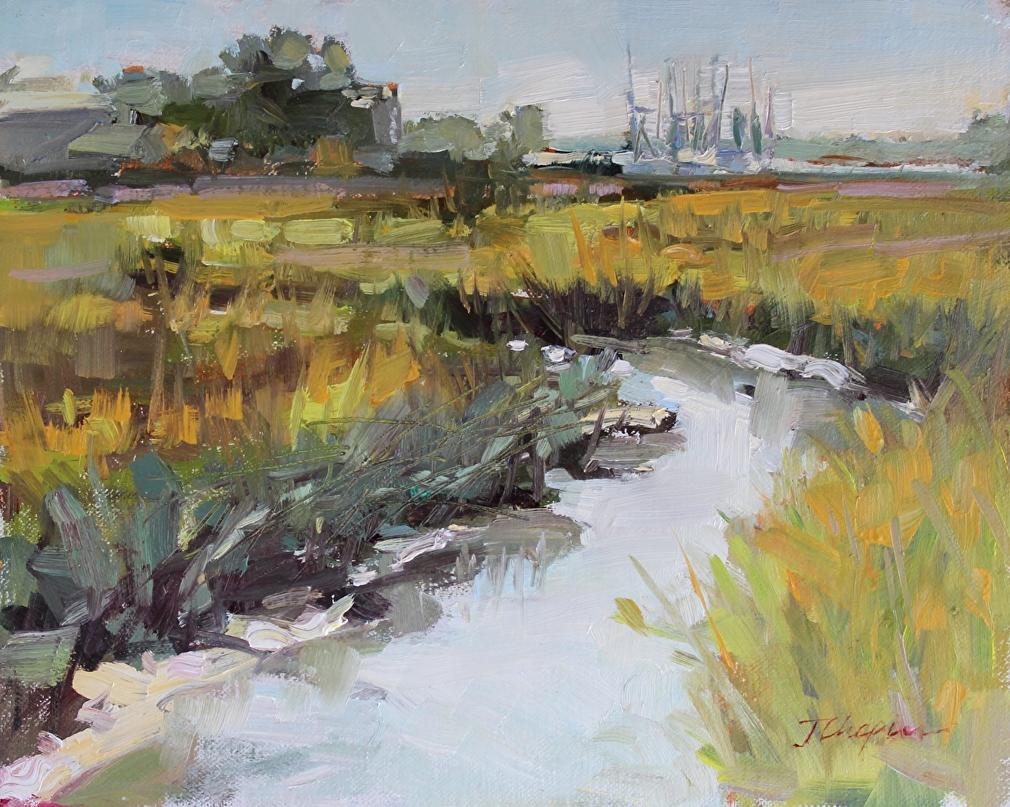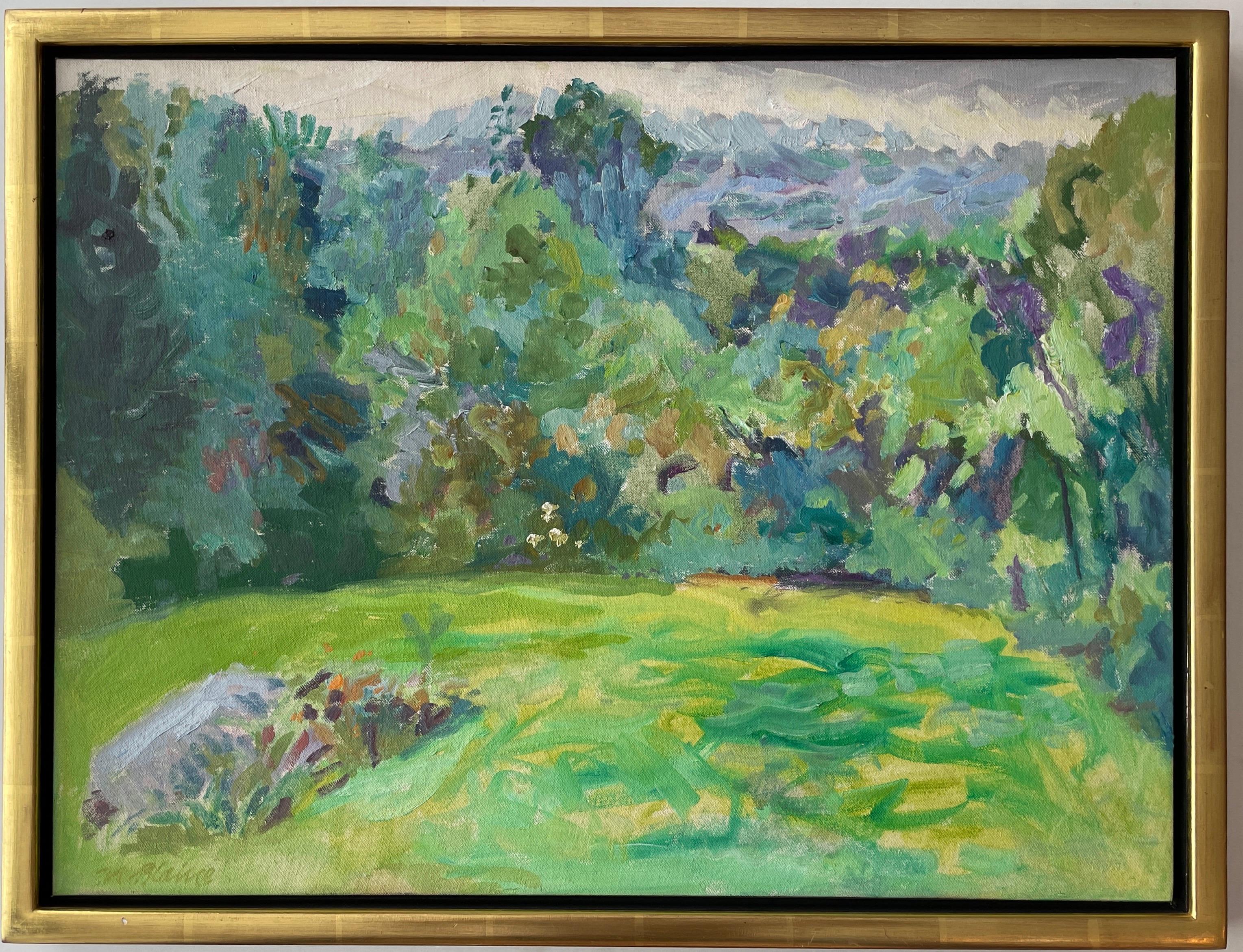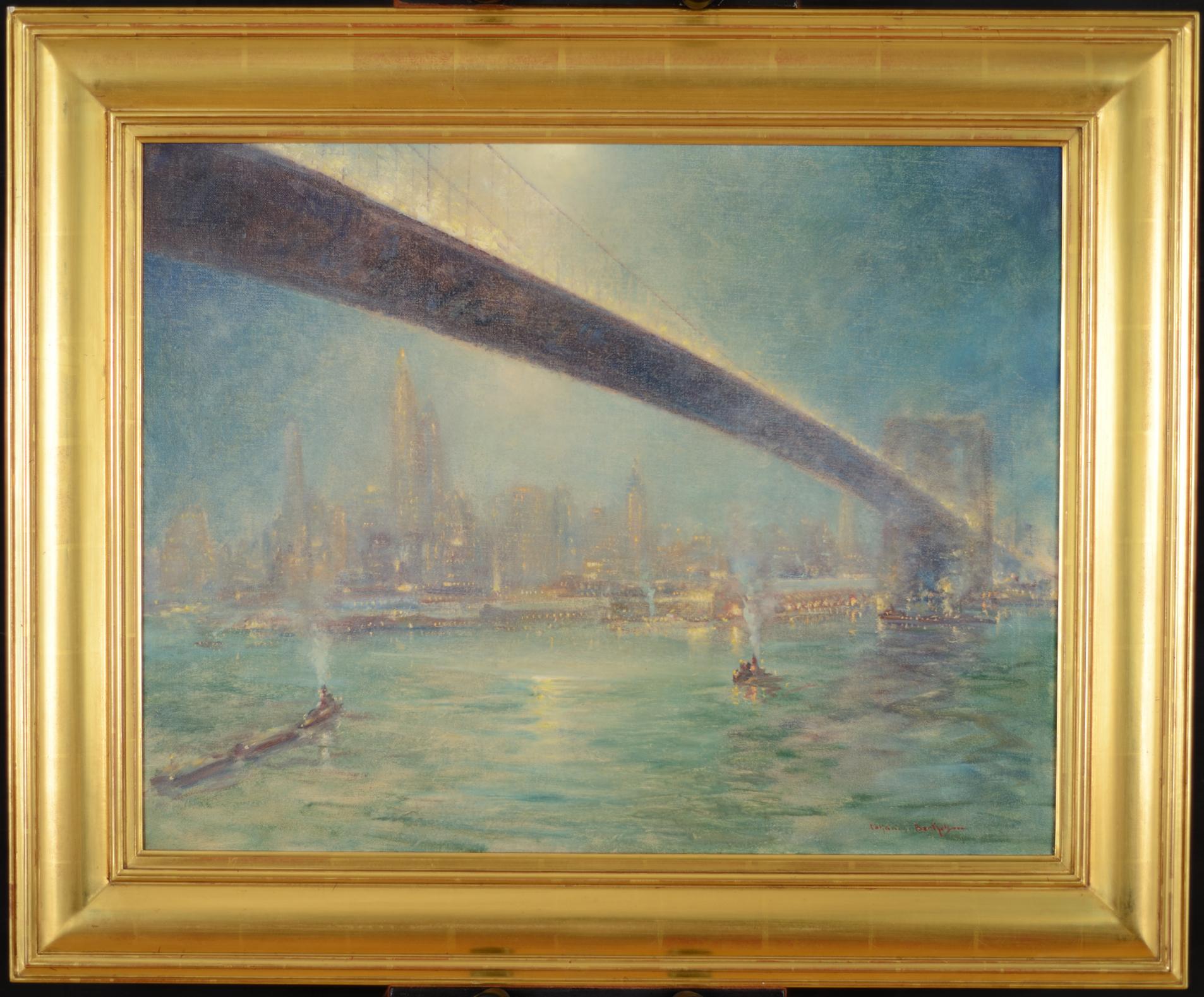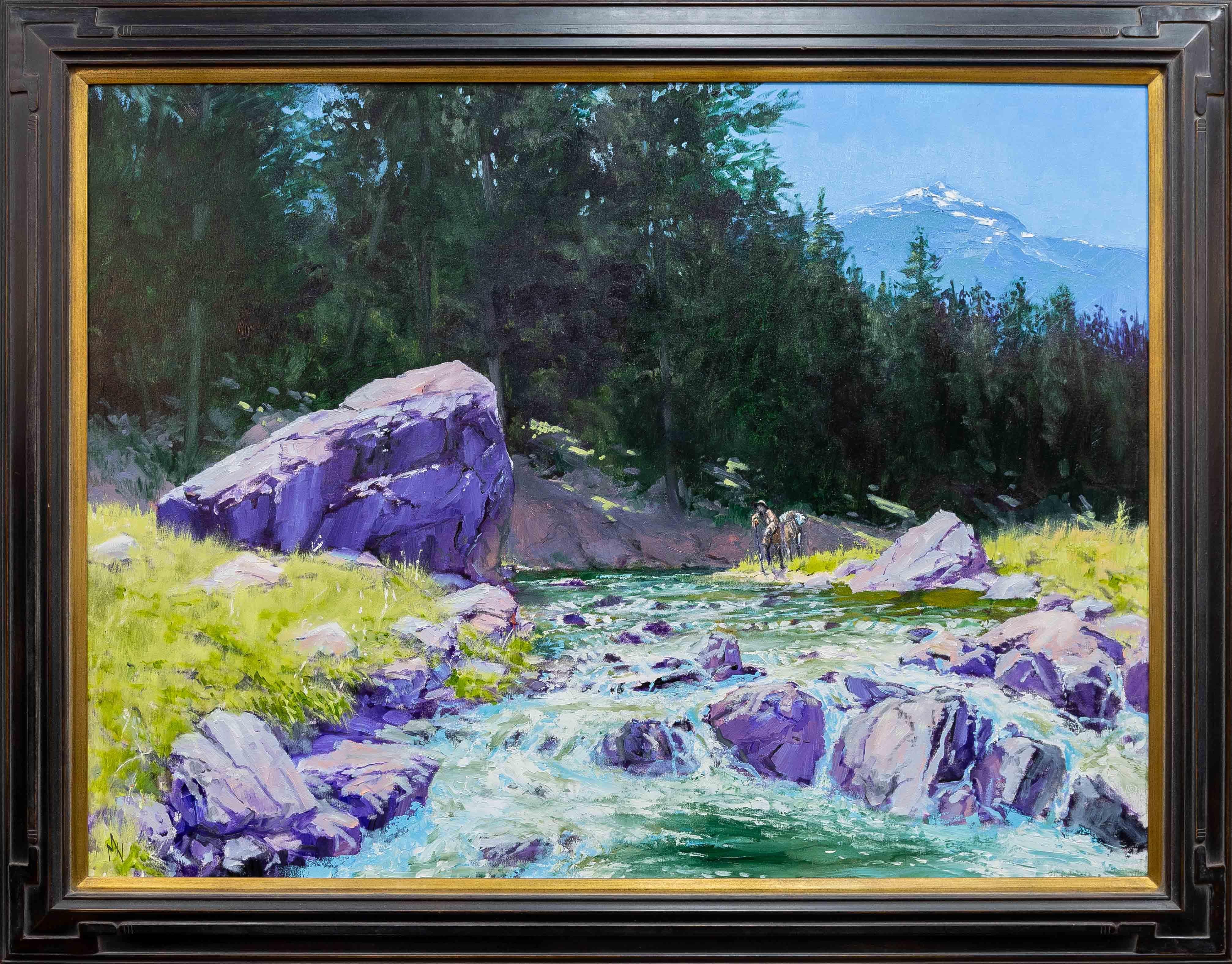Items Similar to Lake Street
Want more images or videos?
Request additional images or videos from the seller
1 of 2
Oscar Daniel SoellnerLake Streetc. 1920s - 30s
c. 1920s - 30s
About the Item
Lake Street, c. 1920 -30s, oil on board, 12 x 9 inches, signed lower right and verso, titled verso
About the Painting
At the center of Oscar Daniel Soellner’s Lake Street, we see the stairway leading to an elevated railway station on what is now Chicago’s Green Line route. When its first section opened in 1893 as the second permanent elevated rapid transit line in Chicago, this route was known as the Lake Street Elevated Railroad. Chicago’s “L,” like the New York subway and rapid transit system, played an instrumental role in the development of the urban economy and the overall look and feel of the city. The formal aspects of urban railroads and the role they played in efficiently moving large number of everyday citizens across America’s growing metropolises were catnip for many American Scene painters during the first half of the 20th Century. Here, Soellner uses the techniques of the impressionists and the palette of the Ash Can School, to convincingly depict a classic Chicago scene.
About the Artist
Oscar Daniel Soellner was an American Scene and landscape painter who lived and worked in Chicago and Grand Detour, Illinois. Born to a German immigrant father who worked as a woodcarver, Soellner took an early interest in art and studied at the Art Institute of Chicago. He was a member of many art organizations in Illinois, including the Chicago Galleries Association, Chicago’s Palette & Chisel Academy and the Illinois Academy of Fine Art. Soellner was also an important member of the Grand Detour Art Colony, which served as a rural escape for many Chicago-based painters and sculptors. His works were exhibited at the Art Institute of Chicago, the National Academy of Design, the Herron Art Institute, and other significant venues. He worked primarily in an impressionist style that served him well in both his urban and rural scenes. His listing in Who was Who in American Art, comments that “His poetic landscapes distinguish him as an important American regionalist.” Soellner is also listed in other standard references.
- Creator:Oscar Daniel Soellner (1890 - 1952, American)
- Creation Year:c. 1920s - 30s
- Dimensions:Height: 12 in (30.48 cm)Width: 9 in (22.86 cm)Depth: 1 in (2.54 cm)
- More Editions & Sizes:17 x 14 x 1 inches (framed)Price: $2,500
- Medium:
- Movement & Style:
- Period:
- Condition:
- Gallery Location:Los Angeles, CA
- Reference Number:1stDibs: LU1859210062822
About the Seller
No Reviews Yet
Vetted Seller
These experienced sellers undergo a comprehensive evaluation by our team of in-house experts.
1stDibs seller since 2022
6 sales on 1stDibs
Typical response time: 8 hours
- ShippingRetrieving quote...Ships From: Los Angeles, CA
- Return PolicyA return for this item may be initiated within 3 days of delivery.
More From This SellerView All
- Knight’s LodgingLocated in Los Angeles, CAThis painting is part of our exhibition American Coast to Coast: Artists of the 1930s Knight’s Lodging, 1941, oil on canvas panel, signed and dated lower left, 16 x 20 inches, exhi...Category
1940s American Realist Figurative Paintings
MaterialsOil
- Amish Farmscape #3By Edmund LewandowskiLocated in Los Angeles, CAAmish Farmscape #3, 1984, oil on canvas, 40 x 30 inches, signed and dated lower right; signed, dated, and titled verso About the Painting Amish Farmscape #3 is part of a multi-painting series of barns completed in the early 1980s for an exhibition at New York’s prestigious Sid Deutsch Gallery. Lewandowski painted this work at an important point in his career. It was the first major project undertaken by Lewandowski after his retirement from serving as the Chairman of Winthrop University’s Art Department, the last academic position he held after teaching for nearly thirty years. Lewandowski had been inspired to work on the series by a visit to Lancaster County, Pennsylvania. Like his friend and mentor, Charles Sheeler, Lewandowski had always been fascinated by vernacular architecture and the Amish barns of Pennsylvania brought back memories of rural scenes Lewandowski had painted in the Midwest much earlier in his career. Amish Farmscape #3 is a strong example of Lewandowski’s late precisionist work. The complexity of the composition and Lewandowski’s technical acumen are on full display. Being relieved of the burdens of teaching and administering a university art department likely allowed Lewandowski greater freedom and most importantly more time to complete the Amish Farmscape series. Although Lewandowski’s brand of precisionism changed throughout the years, he never deviated from the core tenets of the Immaculate School artists. In this work, we see simplified and flattened forms, the use of ray-lines to define light and space, the elimination of extraneous details, a polished almost machine-like finish, and the complete lack of visible brushstrokes, all hallmarks of the precisionist painters. Lewandowski was the last of the 20th century precisionists and in Amish Farmscape #3, we see just how successfully he continued to work in this style until his death in 1998. About the Artist Edmund Lewandowski was among the best of the second-generation precisionist painters. He was born and raised in Milwaukee, Wisconsin and studied at the Layton School of Art with Garrett Sinclair. Lewandowski achieved early success when in 1936 two of his watercolors were shown at the Phillips Collection as part of a Federal Art Project exhibition. Then, in 1937, his work was first exhibited at Edith Halpert’s Downtown Gallery which represented Lewandowski into the 1950s. Under Halpert’s guidance, Lewandowski continued to explore watercolor as his main medium during the 1930s and 1940s, since the gallery already represented Charles Sheeler, who worked primarily in oils. Sheeler became Lewandowski’s major influence as the primary leader of the ill-defined, but very recognizable Immaculate School artists, which included other Downtown Gallery painters, Niles Spencer, George Ault, and Ralston Crawford, as well as Charles Demuth and Preston Dickinson, both of whom died at a young age and had been represented by the Charles Daniel Gallery. Sheeler is credited with giving Lewandowski technical advice on how to make his paintings more precise and tightly rendered and by all accounts, Sheeler was a fan of Lewandowski’s work. Through the Downtown Gallery, Lewandowski’s paintings were accepted into major national and international exhibitions and purchased by significant museums and collectors. Franklin and Eleanor Roosevelt and Nelson Rockefeller acquired works by Lewandowski. He was included in the Museum of Modern Art’s important 1943 exhibition, American Realists and Magic Realists as well as juried exhibitions at the Whitney Museum of American Art, the Pennsylvania Academy of Fine Arts, and the Art Institute of Chicago. Lewandowski also completed commissions for magazines during the 1940s and 1950s, including several covers for Fortune. Throughout his career, Lewandowski explored urban and rural architecture, industry, machinery, and nautical themes. Looking back on his career, Lewandowski wrote, “My overwhelming desire as an artist through the years has been to record the beauty of man-made objects and energy of American industry on canvas. For as far back as I can recall, the cityscapes, farms and depictions of industrial power and technological efficiency has had a great attraction for me. I try to treat these observations with personal honesty and distill these impressions to a visual order.” Lewandowski is credited with extending precisionism to the Midwest and successfully continuing the style into the 1990s, three decades after Sheeler’s death and six decades after Demuth’s passing. Late in his career, Lewandowski enjoyed a resurgence of popularity as he was represented during the 1980s by New York’s Sid Deutsch and Allison Galleries...Category
Mid-20th Century American Modern Landscape Paintings
MaterialsCanvas, Oil
- Moonlight ShantiesLocated in Los Angeles, CAMoonlight Shanties, c. 1940s, oil on canvas, 24 x 18 inches, signed lower right, signed and titled verso About the Painting In Moonlight Shanties, Joachim depicts a lower-class neighborhood sitting along-side an elevated road or railway which crowds out the small nearby houses and structures. Joachim’s use of an expressionist palette and gestural brushstrokes together with the isolated figures obscured in the shadows, create a feeling of unease, isolation and even loneliness. From the 1920s through 1940s, American artists commonly employed expressionist conventions in their social realist works which portrayed the gritty side of urban America, especially the communities of the city-dwelling poor. Expressionist styles were considered appropriate for bridging the gap between the modernist idea of art-for-art’s-sake and the narrative qualities demanded by the dual crises of the Great Depression and World War II. Moonlight Shanties successfully uses these expressionist methods to portray a neighborhood and its people who appear to be literally and figuratively “on the edge.” About the Artist Paul Lamar Joachim...Category
1940s American Modern Landscape Paintings
MaterialsOil
- Landscape with CowsBy Ruth ArmerLocated in Los Angeles, CALandscape with Cows, c. 1930s, oil on canvas, 30 x 24 inches, signed lower middle About the Painting Landscape with Cows is a fine example of California Scene painting, the West Coast version of the American Scene genre practiced during the 1930s and 1940s by the likes of Thomas Hart Benton, Grant Wood and John Steuart Curry. Armer stands out as one of the rare female oil painters working in this style in California, as most of her contemporaries were men whose fame largely depended on watercolor as a medium. Like many Regionalist painters, Armer heeded the call to paint the local scene during the 1930s and even in the depths of the Great Depression, she captured the natural beauty and abundance of the California ranch lands. For many migrants from the Dust Bowl and the southern parts of the United States, California was a golden land of opportunity. In Landscape with Cows, Armer plays on this theme by portraying the fields and distant foothills in a variety of golden hues. This work is a celebration of California’s unique geography, and it fits nicely into the grand tradition of American landscape painting. Armer’s spare treatment of the distant hills and buildings presages the abstract forms she later began to explore in earnest. Like many other artists working during the 1930s, Armer moved strongly towards abstraction by the 1940s, making her critically celebrated California Scene landscapes rare. About the Artist Ruth Armer...Category
1930s American Realist Landscape Paintings
MaterialsOil
- Factory WorkerLocated in Los Angeles, CAThis painting is part of our exhibition America Coast to Coast: Artists of the 1930s Factory Worker, c. 1936, oil on canvas, signed lower right, 18 ¼ x 36 inches; exhibited in City ...Category
1930s American Realist Figurative Paintings
MaterialsOil
- Abstract Street (Untitled)By Hananiah HarariLocated in Los Angeles, CAThis painting is part of our exhibition America Coast to Coast: Artists of the 1930s Abstract Street (Untitled), 1939, oil on canvas, signed and dated lower right, 12 x 32 inches; provenance includes a private collection in Venice, California; presented in what is likely the artist's original handmade frame About the Painting The present work is the culmination of a series of mainly horizontal urban abstractions Harari completed between 1937 and 1939. Deeply influenced by Stuart Davis, Harari’s New York streetscapes began with clearly recognizable objects and landmarks as in Into New York (1937 - Collection of the Whitney Museum of American Art), New York Harbor (1937), Up and Downtown (1938), and his other mural proposals for the Nurses Home on Welfare Island (1937) and the Williamsburg Housing Project (1938). At the end of the series, Harari’s vistas became increasingly abstract with broad planes of color representing buildings and streets, the slightest cross-hatching forming a bridge or elevated train track and the vague suggestion of a streetlight looping in the right center of the composition. Figures, birds, and a street vendor’s cart are reduced to pictograms scratched into the surface of the canvas. Abstract Street (Untitled) is among Harari’s most spare works of the 1930s and 1940s and calls to mind the seemingly childlike, but deeply sophisticated works of Paul Klee from the 1920s. It serves as an excellent reminder of why Harari was heralded as one of the earliest members of the American Abstract Artists. About the Artist Hananiah Harari was an artistic polyglot who was equally at home working in styles as diverse as Cubism, Constructivism, Expressionism, Hard Edged Abstraction and trompe l’oeil Realism. A native of Rochester, New York, Harari initially studied as a child at the Memorial Art Gallery in his hometown and later as a scholarship student at the College of Fine Arts at Syracuse University. In 1932, Harari left for Paris where he befriended Nahum Tschacbasov, Benjamin Benno and John Graham and studied at the ateliers of Lhote, Leger and Gromaire. He also studied fresco painting at the Ecole de Fresque. By 1933, Harari had completed enough work and gained a sufficient reputation to have a solo exhibition at the American Club in Paris. The following year, Harari and his childhood friend and fellow artist Herzl Emanuel traveled to Palestine, where the artists worked hard in the orchards and fields of Kibbutz Deganiah, but produced little art. After returning to New York, Harari married Emanuel’s sister, Freda, and set out on the development of what noted scholar Gail Stavitsky has called an “original synthesis of the old and new." Harari became an early member of the American Abstract Artists (AAA), an organization formed to give modernists exhibition opportunities. Harari was also a member of the socially conscious Artist’s Union and the American Artist’s Congress. From 1936 through 1942, Harari worked on the Federal Art Project and assisted Marion Greenwood on a project as part of the Mural Division, but to his disappointment did not lead his own project. During the late 1930s and early 1940s, Harari completed a series of paired paintings with the same subject matter depicted in a Cubist manner and in trompe l’oeil Realism. Harari was acclaimed by Clement Greenberg and six of the artist’s works were selected for the Museum of Modern Art’s important 1943 exhibition American Realists and Magic Realists. During World War II, Harari served in the US Army Air Corps. Following the war, Harari continued to produce fine art while also producing commercial art. During the McCarthy Era, Harari’s progressive politics and leftist leaning art...Category
1930s American Modern Abstract Paintings
MaterialsOil
You May Also Like
- St. Augustine Skyline Sunset, Impressionist Oil PaintingLocated in Saint Augustine, FLMyers creates an atmospheric scene from the perspective of the inlet looking towards Marine Street, St. Augustine. The burning sunset sky reflects onto the historic skyline casting ...Category
21st Century and Contemporary American Impressionist Landscape Paintings
MaterialsOil
- Pecos Temple (Plein Air landscape Painting - beige neutral colors)By Jane ChapinLocated in Cody, WYThis is a 'Plein Air" landscape Painting by Jane Chapin as seen in the viewing room exhibition on Silas VON MORISSE GALLERY. “Plein-Air” is the French expression to describe the act...Category
2010s American Impressionist Landscape Paintings
MaterialsLinen, Oil, Board
- Coming In & Going Out ( Plein Air Landscape painting green yellow colors)By Jane ChapinLocated in Cody, WYThis is a 'Plein Air" landscape Painting by Jane Chapin as seen in the viewing room exhibition on Silas VON MORISSE GALLERY. “Plein-Air” is the French expression to describe the act of painting in situ within the landscape, capturing the ever changing weather and light with tonal qualities, colour, loose brushwork and softness of form... The practice of “Plein Air Painting” goes back for centuries but was truly made into an art form by the French Impressionists such as Claude Monet, Camille Pissarro, Alfred Sisley, and Pierre-Auguste Renoir who were advocating of plein air painting. Much of their work was done outdoors in the diffuse light of a large white umbrella. Another major proponent of Plein Air was Jean Baptiste Camille Corot whom Claude Monet considered as “The only One Master here”. Corot provides a transition from the sharp academic style that ruled in his day with focus on the natural world and the lyrical expressiveness of one's work. With her "Plein Air Paintings", Jane Chapin is part of one of the largest art movements in history. Her paintings carry human emotions. We can read her moods and feelings with places that carry deep remembrances for the artist that go beyond the descriptive. "My paintings grow from observing and interpretating light as it emerges from, surrounds and reflects on everyday people and scenes. They seek to remind us of the beauty of our common surroundings, regardless of where we are." - Jane Chapin Jane Chapin Painting the Land of the Free...Category
2010s American Impressionist Landscape Paintings
MaterialsLinen, Oil, Board
- Summer, Quaker Hill oil painting by Nell BlaineBy Nell BlaineLocated in Hudson, NYThis work by Nell Blaine was exhibited at the Poindexter Gallery, as well as the Tibor de Nagy Gallery, both in New York City. It is signed lower left, and signed, titled, and dated ...Category
1960s American Impressionist Landscape Paintings
MaterialsOil, Board
- Bridge Nocturne oil painting by Johann BerthelsenBy Johann Berthelsen, 1883-1972Located in Hudson, NYOne of Johann Berthelsen's iconic nocturne views of New York City across the Hudson River. Bridge Nocturne (c.1945) Oil on canvas, 22" x 28" 29 ½" x 36" x 2" framed Signed "Johann ...Category
1940s American Impressionist Landscape Paintings
MaterialsCanvas, Oil
- I Came to Where the Lone Pilgrim Lay, River Landscape Oil on Canvas, Western ArtBy Michael Ome UntiedtLocated in Whitefish, MTI Came to Where the Lone Pilgrim Lay by Michael Ome Untiedt Oil on Canvas, 36" x 48", 43" x 55" (framed), hanging hardware included. From the artist: "In Memory of Tom Horn: This is another of my feeble attempts to break down, to rage against the tyranny of time. I have fought this battle for a half century, yet my limbs grow slower, my hair more moon-bleached. I ponder as I apply brush strokes to the canvas, what thoughts pass through the viewer of this work a hundred years hence, two hundred years later? Will they know what I carry in my heart today? Am I on a great mandala of life, and will I return one day to this same experience, or am I adrift on a great "river" flowing endlessly through the Cosmos, heeding shoal water and seeking shoreline that is forever changing? A dear friend passed this week from the plague scourging our fair land. When and where will I hear his sweet self deprecating laughter again?" Born and raised in rural southeastern Colorado, Michael Ome Untiedt maintains a studio in Denver. Traveling extensively, he is known as a painter of the world who sees with a westerner’s eye. Through the color, brush strokes, and symbolic subject matter of his paintings, he attempts to examine the human predicament and its connections to the landscape and history of the American West. He is driven to portray twenty-first-century psychology on a nineteenth-century saddle! Untiedt has participated in numerous shows including the Western Masters Art Show and Sale, Settler’s West Miniatures Show and Art of the American West...Category
21st Century and Contemporary American Impressionist Landscape Paintings
MaterialsOil, Canvas
Recently Viewed
View AllMore Ways To Browse
Street Number
Large Street Art
Lake Sign
Large Street Art Painting
City Street Landscape Painting
Green Street
Chicago Scenes
Lake Scenes
American Immigrant
Urban Landscape Street Art
Lake Scene Painting
Large Urban Landscape
Chicago Street Signs
German Painting 1920s
Impressionist Oil Lake
Large Lake Landscape Paintings
Painting Chicago Lake
Chicago Street Scene





